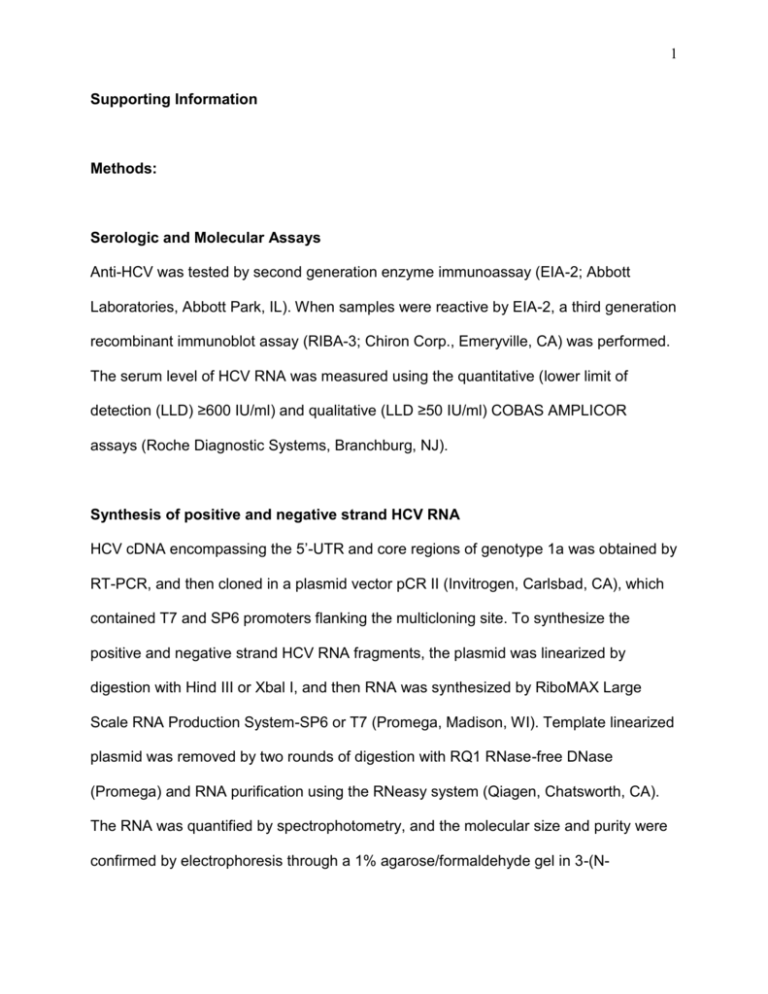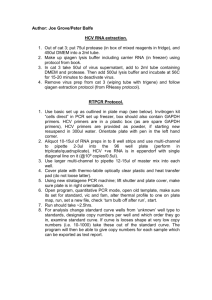HEP_25921_sm_SuppInfo
advertisement

1 Supporting Information Methods: Serologic and Molecular Assays Anti-HCV was tested by second generation enzyme immunoassay (EIA-2; Abbott Laboratories, Abbott Park, IL). When samples were reactive by EIA-2, a third generation recombinant immunoblot assay (RIBA-3; Chiron Corp., Emeryville, CA) was performed. The serum level of HCV RNA was measured using the quantitative (lower limit of detection (LLD) ≥600 IU/ml) and qualitative (LLD ≥50 IU/ml) COBAS AMPLICOR assays (Roche Diagnostic Systems, Branchburg, NJ). Synthesis of positive and negative strand HCV RNA HCV cDNA encompassing the 5’-UTR and core regions of genotype 1a was obtained by RT-PCR, and then cloned in a plasmid vector pCR II (Invitrogen, Carlsbad, CA), which contained T7 and SP6 promoters flanking the multicloning site. To synthesize the positive and negative strand HCV RNA fragments, the plasmid was linearized by digestion with Hind III or Xbal I, and then RNA was synthesized by RiboMAX Large Scale RNA Production System-SP6 or T7 (Promega, Madison, WI). Template linearized plasmid was removed by two rounds of digestion with RQ1 RNase-free DNase (Promega) and RNA purification using the RNeasy system (Qiagen, Chatsworth, CA). The RNA was quantified by spectrophotometry, and the molecular size and purity were confirmed by electrophoresis through a 1% agarose/formaldehyde gel in 3-(N- 2 morpholino) propanesulfonic acid buffer. Synthesized HCV-RNA copy numbers were calculated from the quantity and molecular weight of RNA according to conventional methods (1). RNA extraction and purification from plasma, uncultured PBMC or tissue samples RNA was extracted from PBMC or tissue samples with Trizol reagent (Invitrogen, Carlsbad, CA) or using the RNeasy Plus kit (Qiagen, Valencia, CA) according to the manufacturer’s instructions. For plasma samples from recovered subjects, MagMAXTM Viral RNA Isolation Kit (Ambion, Austin, TX) was used. To detect low copy number of HCV RNA in plasma, a modification to the pre RT-PCR step was performed. Briefly, 1.6 ml of plasma was aliquoted into 4 tubes and RNA extraction was performed with MagMAXTM Viral RNA Isolation Kit according to the manufacturer’s protocol. 50 µl of each buffer elution was added to dissolve viral RNA and subsequently four aliquots of each 50 ul final elution were combined; RNA was further purified and concentrated using RNeasy MinElute Cleanup Kit (Qiagen, Chatsworth, CA). Total RNA from 1.6 ml of plasma sample was eluted in 24 µl of buffer and thus, the 10 µl of purified RNA in each RT-PCR reaction corresponded to 667 μl of original plasma volume. Purification of HCV RNA from culture supernatants and cultured cells With the objective of concentrating the virus, 1 ml of culture SN was subjected to polyethylene glycol 8000 precipitation at final concentration of 8% (W/V) and then solubilized with buffer RLT Plus (Qiagen , Chatsworth, CA) with 1% 2-mercaptoethanol. 3 After adding the RNA carrier, HCV RNA extraction was performed with the QIAmp viral RNA minikit (Qiagen, Chatsworth, CA) following the manufacturer’s instructions. Cellular RNA was extracted from cultured cells with RNeasy Plus minikit according to the manufacturer’s protocol. The purified RNA was quantified and 1µg of total RNA was used per PCR for every sample. HCV detection We followed the RTD-PCR method designed by Takeuchi et al. (1); however, to obtain better sensitivity, nested-RTD PCR was performed, as reported previously for the detection of HCV (2, 3). Briefly, the first round RT-PCR was performed using thermostable rTth polymerase (GeneAmp EZ rTth RNA PCR kit, Applied Biosystems, Foster City, CA) and primer set KK30 (5’-CTGTCTTCACGCAGAAAGCG-3’) and KM3 ( 5’CACTCGCAAGCACCCTATCA-3’ (1). After reverse transcription for 30 minutes at 60ºC, and initial denaturing at 95ºC for 2 minutes, amplification was performed with 15 cycles of denaturing at 95ºC for 20 seconds and annealing and extension at 60ºC for 1 minute, followed by final extension at 72ºC for 7 min. The nested-RTD PCR was performed using the primer set R6-130-S17 (5’CGGGAGAGCCA TAGGTGG-3’), R6290-R19 5’-AGTACCACAAGGCCTTTCG-3’) and Taqman probe R6-148-S21FT (6FAM-5’-CTGCGGAACCGGTGAGTACAC-3’-TAMRA) (1). 3 microliter of PCR product was mixed with the primer sets, the probe, and Taqman Universal PCR Master Mix (Applied Biosystems). After initial denaturing at 95ºC for 10 minutes, amplification was performed with 40 cycles of denaturing at 95ºC for 20 seconds and annealing and extension at 60ºC for 1 minute in Prism 7900HT Sequence Detection System (ABI). 4 Quantitative linearity was obtained from 5 to 106 copies per assay. When diluted WHO HCV standard was used, the detection limit of this nested-RTD PCR with our RNA extraction-purification method from plasma was 10 IU per ml. For RNA isolated from PBMC, the assay can detect 2 copies/µg total RNA. HCV negative strand detection For negative strand HCV RNA detection, the rTth based method (4, 5) (rTth DNA polymerase and Buffer kit, Applied Biosystems) was used with minor modification. Briefly, RNA was denatured at 95ºC for 1 min and then kept at 70ºC followed by the addition of a reagent mix containing sense primer KK30 and rTth RNA polymerase preheated at 70 ºC. RT was performed at 60ºC for 2 minutes and then 70 ºC for 25 minutes. While the mixture was kept at 70ºC, chelating buffer pre-heated at 70ºC was added followed by a PCR reagent mix containing the primer KM3 preheated at 70ºC. After the initial denaturing at 95ºC for 3 minutes, 15 cycles of PCR reaction was performed with denaturing at 95ºC for 30 seconds, annealing at 60ºC for 30 seconds, followed by the final extension at 72ºC for 30 seconds. 3 microliter of PCR product was used for the subsequent nested-RTD PCR. Synthesized negative- strand HCV RNA of 10 to 106 copies per assay was used as the positive quantitative standard and synthesized positive strand HCV RNA of 10-106 copies per assay was used as the negative control. Quantitative linearity was obtained from 50 to 106 copies, and the detection limit was 50 copies per assay. False positive results were observed when ≥106 copies per assay of positive strand HCV RNA were in the reaction. 5 References 1. Takeuchi T, Katsume A, Tanaka T, Abe A, Inoue K, Tsukiyama-Kohara K, et al. Real-time detection system for quantification of hepatitis C virus genome. Gastroenterology 1999;116:636-642. 2. Bernardin F, Tobler L, Walsh I, Williams JD, Busch M, Delwart E. Clearance of hepatitis C virus RNA from the peripheral blood mononuclear cells of blood donors who spontaneously or therapeutically control their plasma viremia. Hepatology 2008;47:1446-1452. 3. Nicot F, Kamar N, Mariamé B, Rostaing L, Pasquier C, Izopet J. No evidence of occult hepatitis C virus (HCV) infection in serum of HCV antibody-positive HCV RNA-negative kidney-transplant patients. Transpl Int. 2010; 23: 594-601. 4. Radkowski M, Gallegos-Orozco JF, Jablonska J, Colby TV, Walewska-Zielecka B, Kubicka J, Wilkinson J, et al. Persistence of hepatitis C virus in patients successfully treated for chronic hepatitis C. Hepatology 2005;41:106-114. 5. Lanford RE, Chavez D. Strand-specific rTth RT-PCR for the analysis of HCV replication. In: J.Y.N. Lau ed. Hepatitis C Protocols. Totowa, NJ: Humana Press, 1998:471-481.




